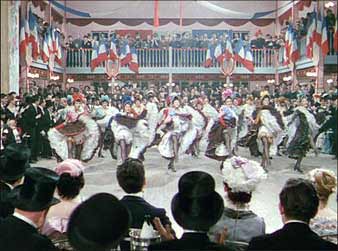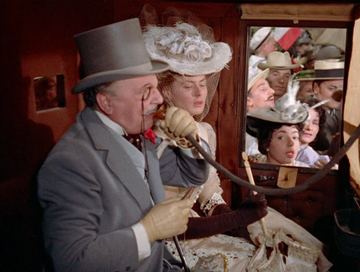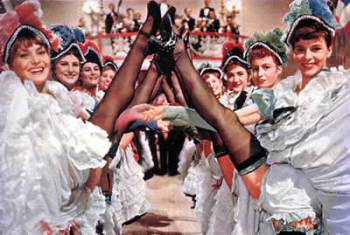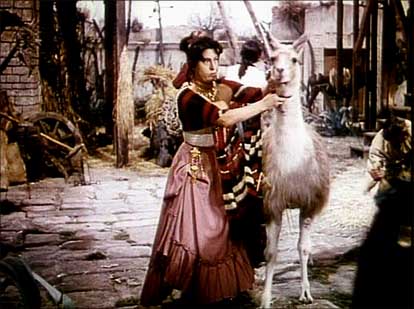The following, which I wrote circa March 2004, was commissioned for a Criterion box set; my thanks to Liz Helfgott, my editor there, for giving me the go-ahead to reprint this. — J.R.
Jean Renoir’s Trilogy of Spectacle
by Jonathan Rosenbaum
Movie trilogies can be created by either filmmakers or critics. When Pier Paolo Pasolini wrote and directed The Decameron (1971), The Canterbury Tales (1972), and Arabian Nights (1973), he made no bones about calling them his Trilogy of Life. But when Michelangelo Antonioni followed L’avventura (1960) with La notte (1961) and L’eclisse (1962), the intention was mainly apparent in the titles and a few echoes noted by critics, such as the presence of building sites at the beginning of the first and at the end of the third. As for the so-called Koker trilogy of Where is the Friend’s House? (1986), Life and Nothing More… (1992), and Through the Olive Trees (1994), Iranian writer-director Abbas Kiarostami explicitly refuses to yoke them together in this fashion—–which hasn’t prevented many critics and programmers from doing so.
Jean Renoir’s The Golden Coach (1953), French Cancan (1955), and Eléna et les hommes (1956), preceding all of these, belongs somewhere in the vicinity of the last two examples. Renoir never planned them as a trilogy; the ways they sprang into being—–including his taking over the projects of others in the first two cases—–were far too haphazard to permit such forethought. Yet he often joined critics in discussing them together—as if they comprised three manifestations of the same impulse. In fact, they all have heroines who move between three lovers–—heroines who are forced to choose between art and life and who ultimately opt for art in some fashion. (To complicate matters in French Cancan, one of the three lovers, played by Jean Gabin, passes between three lovers of his own.)
Furthermore, the multinational aspects of these movies bring them closer to Pasolini’s trilogy. The Golden Coach, a film in English set in a Spanish colony of Peru at the beginning of the 18th century, was inspired by Vivaldi’s music and shot in an Italian studio by a French director. French Cancan, the most purely French of the threesome in terms of language, setting, and characters, situated in Paris in the 1880s, none the less has an Italian prince (Gianni Esposito), Russian sailors, and a half-Spanish diva (played by Mexican actress Maria Félix) performing an Egyptian belly dance at a cabaret called The Chinese Screen. Eléna, a Franco-Italian coproduction, also set in France in the 1880s and also with French dialogue—although it was originally planned to be shot in French and English versions, and had to be simplified once the actors proved to be unequal to the task—–stars a Swedish actress (Ingrid Bergman) playing a Polish princess opposite an American actor (Mel Ferrer) playing a French dandy.
As a consequence of such artifice, these films are far removed from the sociopolitical focus of Renoir’s great French films of the Thirties, even though it might also be argued that their multinational attributes bring them a certain kind of universality. (They’re also, as Christopher Faulkner has noted, consciously ahistorical [1], distorting known facts about the founder of the Moulin Rouge in French Cancan and General Boulanger in Eléna by turning them into fictional characters, Danglard and General Rollan respectively.) From this standpoint, the uses of Vivaldi in The Golden Coach arguably function rather like the use of Vivaldi at the end of Life and Nothing More… “For me,” Kiarostami has said, “classical music belongs to everywhere and everyone and, just like the sky, has no nationality or geography.” (The other two films reflect Renoir’s long-standing desire to create a film musical or opera, fulfilled only in his last feature, Le Petit Théatre de Jean Renoir in 1971).
It might be said that the studio filmmaking that Renoir became involved with in the 50s aspired to a similar universality. Following his wartime emigration to Hollywood, which produced an uneasy mix of French and American subjects (This Land is Mine and Diary of a Chambermaid versus Swamp Water, The Southerner, and Woman on the Beach), he made a 1950 feature, The River, that introduced him to both color and to India–—though this was an India filtered through the sensibility of a fictional English family. The relatively expensive, difficult, and studio-made star vehicles that followed were all steps in negotiating his return to French filmmaking—–not an easy task for a filmmaker whose 1939 masterpiece The Rules of the Game was hooted off the screen by French audiences, who subsequently left France in despair, and who was then scorned by some French critics for having fled. Furthermore, of the three, only French Cancan was a commercial success, and even that film was hampered by interference from the producers, including substantial cuts. (2)
***
All three films are comic period fantasies in dazzling color, offering a kind of continuous bustling choreography in which shifting power relations between upper and lower classes and between spectators and performers literally turn the world into a kind of theater. In this respect, they might be said to offer more abstract and less politically anchored versions of the films Renoir made during the Thirties. Unlike their predecessors, they’re deliberately removed from real life. And given the sense of political as well personal defeat that came with the war and his departure from France, followed by a lengthy period of living in exile, they’re unable to hide a subtle aftertaste of regret lurking behind all the gaiety—a sense that utopia can only be found, if at all, on a soundstage, not in the Popular Front that once meant so much to Renoir. This sadness only occasionally rises to the surface, as in the memorable exchanges between actors Camilla (Anna Magnani) and Don Antonio at the very end of The Golden Coach. “Felipe, Ramon, the Viceroy…disappeared.” “Now they are part of the audience. Do you miss them?” “A little.” One might also cite the exquisite final shot of French Cancan, both wistful and triumphant, showing the cabaret exterior in extreme long shot as a drunk staggers away and then takes a mock bow –an image that anticipates the vision of Jacques Tati in Playtime (1967) and Parade (1974) of the spectator as performer. This is echoed, moreover, by two lovely bits of pantomime in the two other films: in The Golden Coach, a bullfight perceived by us exclusively through Camilla’s reactions, and, in Eléna, a physical assault on Jean Marais’ General Rollan by Henri, conveyed through the gestures of an excited male spectator. Even the modest conclusion of Eléna, after the end title, reintroduces Ingrid Bergman’s name in the midst of a fictional newspaper story.
Should one interpret these self-referential moments as acknowledgements of life or as celebrations of art? That they’re both only begins to describe them adequately. As a motto for their emotional complexity, consider this crucial exchange between Henri and Eléna: “When drilling for oil, choosing a government, or making explosives, we may be a trifle off the mark. But when it comes to the art of living, you may have faith in the French.” “Let’s pretend.”
The art of living which these movies celebrate, in short, is seen above all as the capacity for imagination and pretense. Yet at the same time, paradoxically, because imagination and pretense are also periodically felt to be second-best solutions — consolation prizes in the absence of true fulfillment — there’s also a sense in which these movies appear to lament their presence, or at least to regard them more bitter-sweetly. Two key moments in the preceding films illustrate aspects of Renoir’s emotional ambivalence: Camilla breaks into helpless laughter when the Viceroy (Duncan Lamont) asks her permission to sit down; and when Danglard (Gabin), French Cancan’s impresario, is about to be evicted from his hotel room, his mistress-discovery Nini (Françoise Arnaud) impulsively orders a bottle of champagne from room service.
It’s been suggested that these movies comprise a Trilogy of Art, but I’d rather call them a Trilogy of Spectacle, thus placing them in an ambiguous netherworld between life and art. This helps to underline the modernity of Renoir’s cinema — the modernity that we often associate with self-referential art — especially for those who tend to limit his art unnecessarily to the realism and humanism of Grand Illusion, a reading that Renoir himself was often at pains to challenge. “The saving grace of cinema,” he wrote in his autobiography, “is that with a little patience, and with love, by avoiding conventional make-up and taking liberties with orthodox lighting, we may arrive at that wonderfully complex creature which is called Man.” (3)
Above all, anticipating a major strain in the modernism we associate with the French New Wave and its aftermath (such as the films of Robert Altman) is the inscription of the experience of making a film onto the illusionist experience of watching one. Bridging the sense of play and chance that determines the conditions of both experiences, this essentially bifocal vision guarantees some elements of documentary behind every fiction, a distinguishable counterline intertwined around each thread in a plot which makes the movie a compromise between a theory and a philosophy of life on the one hand, the vicissitudes of writing, casting, shooting, and editing on the other. No doubt the most legendary viewing of a Renoir film by a future New Wave director was Jacques Rivette turning up at the first commercial screening of The Golden Coach in Paris at 2 p.m. and remaining in the theater until midnight — a gesture prefiguring not only his lengthy movies but also his firm conviction, shared with Jean-Luc Godard, that everything a charismatic actor does is interesting, ordinary verisimilitude be damned.
Let me conclude with a particular gloss on this process offered by Renoir’s most perceptive and theoretically minded critic, André Bazin:
“…Renoir directs his actors as if he liked them more than the scenes they are acting and preferred the scenes which they interpret to the scenario from which they come. This approach accounts for the disparity between his dramatic goals and the style of acting, which tends to turn our attention from his aims. This style is added to the script like rich paint liberally applied to a line drawing: often the colors obscure and spill over the lines. This approach also explains the effort required to enjoy half the scenes Renoir directs. Whereas most directors try to convince the viewer immediately of the objective and psychological reality of the action and subordinate both action and directing to this end, Renoir seems to lose sight of the audience from time to time. His players do not face the camera but each other, as if acting for their personal pleasure.” (4)
Viewing the same process more in thematic terms, Raymond Durgnat once neatly encapsulated all three of the films in Renoir’s makeshift trilogy and their interrelations in a single sentence: “Show-business is sad because a concomitant of stardom is the renunciation of life; show-business is happy because it’s an apotheosis of life; politics is only a very dangerous form of show-business.” (5)
Put all three of these postulates together and one arrives at the template for Altman’s Nashville (1975) —- not to mention a great deal else in modern cinema. As Bazin suggests, the actors are employed as if they were different kinds of paint, freely spilling over the initial designs, but it’s worth adding that the colors are employed on occasion as if they were actors —- a splash of yellow or blue in an incidental décor carrying all the allure of a memorable extra.
Notes
1. The Social Cinema of Jean Renoir by Christopher Faulkner, Princeton, NJ: Princeton University Press, 1986, p. 183.
2. Jacques Rivette, who worked as an apprentice on the production, has recently recalled some of the lamentable losses in La Lettre du Cinéma (“À propos de Jean Renoir,” Janvier/Février/Mars 2004, no. 25, pp. 31-37).
3. My Life and My Films by Jean Renoir, translated by Norman Denny, New York: Atheneum, 1974, p. 205.
4. Jean Renoir by André Bazin, translated by W.W, Halsey II and William H. Simon, New York: Dell Publishing, 1973, pp. 75 & 77.
5. Jean Renoir by Raymond Durgnat, Berkeley/Los Angeles: University of California Press, 1974, p. 400.






